 |

Theobromine
The caffeine-like alkaloid
in chocolate that is good for you

Rob Lyon, George Mitchell and Claudia Orellana
Hereford Sixth Form College.

Molecule of the Month March 2020
Also available: JSMol version.

|
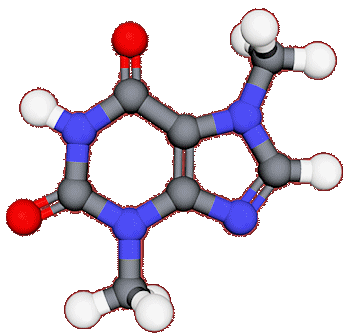 |
It doesn’t contain Bromine?!
No. Despite what the name suggests, a molecule of theobromine contains no bromine atoms. The name is derived from Theobroma, which is the genus of the cacao tree (Theobroma cacao). The suffix '-ine' indicates that it is an alkaloid.
Where does it come from?
Theobromine is primarily found in cocoa beans, accounting for approximately 1.2% of their mass. This is why theobromine is best known for being in chocolate. Its concentration in milk chocolate is about 0.001-0.005%, significantly less than what you’d find in dark chocolate – roughly 0.01%. This is because dark chocolate contains a higher percentage of cocoa solids. As well as cocoa beans, theobromine can be found in trace amounts in the kola nut, the tea plant and the guarana berry.
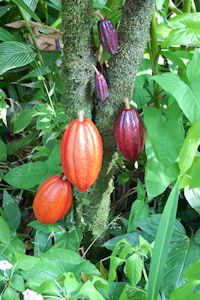
Cocoa pods
Photo by Medicaster. [Public domain via Wikimedia] |
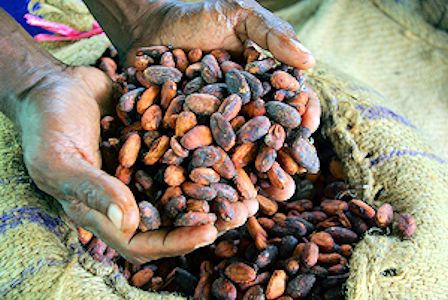
Dried cocoa beans ready for export.
Photo by Irene Scott/AusAID [CC BY via Wikimedia]] |
Is it similar to caffeine?
They both belong to the same branch of xanthine alkaloids and structurally they are very similar. They differ by just a single methyl group, which explains the similarities on how they affect living organisms. However, this extra methyl group in caffeine does make a difference in some ways.
 |
 |
| Theobromine |
β-Caffeine |
So, what does it do to us?
Most of us are familiar with the effect of caffeine on humans. Theobromine is known to produce some similar effects. These become most interesting when it is consumed in excess. If you have ever binged out on dark chocolate, you may have experienced severe headaches, sweating and trembling. These symptoms can be attributed to theobromine’s vasodilatory and cardiac stimulatory properties; all of which are typical of the xanthine alkaloid family.
|
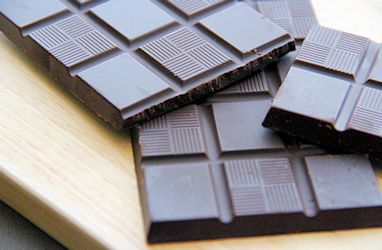
Dark Chocolate
Photo: Debora Cartegena [Public domain, via Wikimedia] |

Photo: American kennel Club |
And what does it do to our pets?
It is well known that chocolate is poisonous to dogs. If you’ve ever wondered why, here’s your answer. Dogs (and cats – although they’re less likely to be attracted to chocolate in the first place, as they can’t taste sweetness) metabolise theobromine much more slowly than humans. This means that a dog’s toxic dose is substantially lower than that for a human. Your faithful friend can suffer from theobromine poisoning after consuming as little as 50 grams (1.8 oz) of milk chocolate for a smaller dog and 400 grams (14 oz), for an average-sized dog. An even smaller amount of dark chocolate would suffice to make your pet ill. The symptoms include: digestive problems, dehydration, excitability, and a slow heart rate. In later stages of theobromine poisoning dogs can undergo epileptic-like seizures and death. If caught early though, theobromine poisoning is completely treatable.
|
Theobromine poisoning is not restricted to domestic animals. In 2014, four American black bears were found dead in New Hampshire. The post mortem suggested that the bears had died of heart failure following the consumption of 41 kilograms of chocolate and doughnuts.
And how can the effects of theobromine be explained?
It is mainly to do with adenosine (see: MOTM for Jan 1998), a small molecule which has a strong neuro-regulatory action in the central nervous system, among other functions. Because their structures are quite similar to that of adenosine, theobromine and caffeine can bind to adenosine receptors instead of adenosine. This phenomenon is known as antagonism – so theobromine and caffeine have an antagonistic effect on adenosine receptors. Brain physiology is strongly affected by variations in the concentration of adenosine which binds to adenosine receptors in neurones. They also affect blood pressure, which explains the headaches and trembling. But caffeine is much faster at binding to adenosine receptors than theobromine and is also better at crossing the blood-brain barrier. This means its stimulant effect is greater in the central nervous system. So, while theobromine can act as a heart stimulant and smooth muscle relaxant, caffeine better enhances physical performance and alertness. This also means that caffeine has potentially more adverse side effects.
|
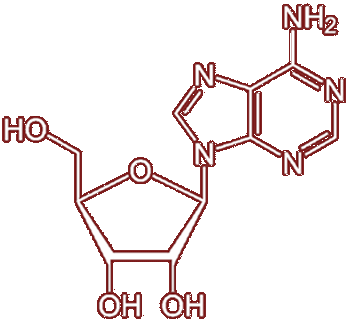
Adenosine |
Every serious chocolate lover knows that chocolate is good for you. Could this be down to theobromine?
 Yes. Theobromine has been found to be have beneficial effects, for instance, on asthma and other respiratory conditions. It has the potential to be used as a cough medicine, but no product of this sort has been developed yet. Perhaps it’s worth trying a hot chocolate drink next time you have a cold. Just don’t let your dog try it. Preliminary results suggest that theobromine and caffeine have a different capability for tissue penetration and accumulation, so theobromine may achieve greater effects than caffeine for soothing coughs. But if you are taking cocoa as a medicinal product as opposed to purified theobromine, you should take into account the fact that cocoa contains some caffeine too.
Yes. Theobromine has been found to be have beneficial effects, for instance, on asthma and other respiratory conditions. It has the potential to be used as a cough medicine, but no product of this sort has been developed yet. Perhaps it’s worth trying a hot chocolate drink next time you have a cold. Just don’t let your dog try it. Preliminary results suggest that theobromine and caffeine have a different capability for tissue penetration and accumulation, so theobromine may achieve greater effects than caffeine for soothing coughs. But if you are taking cocoa as a medicinal product as opposed to purified theobromine, you should take into account the fact that cocoa contains some caffeine too.
A couple of studies on volunteers taking cocoa have shown a significant increase on HDL-cholesterol (good cholesterol, see MOTM for March 2014) levels and decrease in LDL-cholesterol (bad cholesterol). This implies a preventative effect against cardiovascular disease. Studies have also shown that theobromine protects tooth enamel and has anticancer activity.
It should be mentioned that cocoa contains high levels of antioxidants, so the beneficial effects are not only down to theobromine, but also to its high flavonoid content. But theobromine has antioxidant activity of its own: even though its main mechanism of action is the blockage of adenosine receptors, interestingly, it also shows a reduction of cellular oxidative stress. So, yes, theobromine can be considered beneficial and may become a useful molecule in the development of novel drugs. The bottom line is that chocolate (minus the sugar) is indeed good for you!
Studies also suggest that the psychoactive component of theobromine and caffeine plays a role in our liking for chocolate and coffee, as it has a positive influence on our mood and state of alertness. The good news is that other research has found that theobromine is not addictive. What’s not to like!

Bibliography
General background
Scientific studies
- Choi O. H., Shamim M. T., Padgett W. L., Daly J. W. (1988). Caffeine and theophylline analogues: correlation of behavioral effects with activity as adenosine receptor antagonists and as phosphodiesterase inhibitors. Life Sci. 43, 387–398
- Kargul B., Özcan M., Peker S., Nakamoto T., Simmons W. B., Falster A. U. (2012). Evaluation of human enamel surfaces treated with theobromine: a pilot study. Oral Health Prev. Dent. 10, 275–282.
- Khan N., Monagas M., Andres-Lacueva C., Casas R., Urpí-Sardà M., Lamuela-Raventós R. M., et al. (2012). Regular consumption of cocoa powder with milk increases HDL cholesterol and reduces oxidized LDL levels in subjects at high-risk of cardiovascular disease. Nutr. Metab. Cardiovasc. Dis. 22, 1046–1053
- Mokry J., Nosalova G., Mokra D. (2009). Influence of xanthine derivatives on cough and airway reactivity in guinea pigs. J. Physiol. Pharmacol. 60, 87–91.
- Sugimoto K., Simard J., Haagensen D. E., Labrie F. (1994). Inverse relationships between cell proliferation and basal or androgen-stimulated apolipoprotein D secretion in LNCaP human prostate cancer cells. J. Steroid Biochem. Mol. Biol. 51, 167–174.


 Back to Molecule of the Month page. [DOI:10.6084/m9.figshare.11905545]
Back to Molecule of the Month page. [DOI:10.6084/m9.figshare.11905545]

![]()
![]()
![]()
![]()








 Yes. Theobromine has been found to be have beneficial effects, for instance, on asthma and other respiratory conditions. It has the potential to be used as a cough medicine, but no product of this sort has been developed yet. Perhaps it’s worth trying a hot chocolate drink next time you have a cold. Just don’t let your dog try it. Preliminary results suggest that theobromine and caffeine have a different capability for tissue penetration and accumulation, so theobromine may achieve greater effects than caffeine for soothing coughs. But if you are taking cocoa as a medicinal product as opposed to purified theobromine, you should take into account the fact that cocoa contains some caffeine too.
Yes. Theobromine has been found to be have beneficial effects, for instance, on asthma and other respiratory conditions. It has the potential to be used as a cough medicine, but no product of this sort has been developed yet. Perhaps it’s worth trying a hot chocolate drink next time you have a cold. Just don’t let your dog try it. Preliminary results suggest that theobromine and caffeine have a different capability for tissue penetration and accumulation, so theobromine may achieve greater effects than caffeine for soothing coughs. But if you are taking cocoa as a medicinal product as opposed to purified theobromine, you should take into account the fact that cocoa contains some caffeine too.